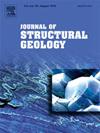先存损伤对砂岩动态破碎行为的影响
IF 2.9
2区 地球科学
Q2 GEOSCIENCES, MULTIDISCIPLINARY
引用次数: 0
摘要
上地壳岩石先前存在的损伤改变了它们的本构行为,降低了强度,改变了近地表动态加载过程(如地震破裂、撞击坑和滑坡)中的破碎。为了研究在这些条件下预先存在的损伤对脆性破碎的影响,我们研究了热处理砂岩在动态拉伸载荷下的行为。热处理引起微裂缝和矿物学变化,模拟了由于构造变形、挖掘和断层引起的损伤而可能存在的预先存在的损伤。采用一种改进的霍普金森压力杆(SHPB)装置,对经过250°C、450°C、650°C和850°C热处理的Berea砂岩样品进行拉伸破碎,并使用光学和扫描电子显微镜分析死后样品的变形。实验过程中的永久应变通过i型裂缝的形成、扩张带和孔隙空间的扩张来适应,这可能导致局部孔隙度增加高达25%。拉伸强度随热处理温度升高而升高,但在α-β-石英相变温度以上时,拉伸强度降低。Berea砂岩的弹性特性也随着热处理而改变,在250℃以上的热处理中,单一方向的泊松比变为负值。在温度高达450°C的砂岩中,SHPB实验诱导的裂缝主要是晶间裂缝,而在650°C和850°C的砂岩中,晶内裂缝更为普遍。在拉伸加载的试样中观察到由晶粒接触产生的晶内裂纹,但它们的形成机制不同于在压缩下形成的形态相似的“赫兹”裂纹。我们提出了一个在远端拉应力场下形成的接触源拉伸裂缝模型,该模型类似于在压缩载荷下形成的赫兹裂缝。最后,我们将实验损伤样品与来自俄亥俄州圣安德烈亚斯断层和蛇丘冲击构造损伤带的自然变形砂岩进行了比较,我们显示出明显的特征,可能表明在宏观拉伸载荷下形成的脆性损伤。我们的研究结果对地震破裂、山体滑坡和撞击坑中预先存在损伤的砂岩的动态拉伸脆性破碎具有启示意义。重要的是,这些结果为将动态加载条件和过程与砂岩脆性损伤的现场观测联系起来提供了新的见解。本文章由计算机程序翻译,如有差异,请以英文原文为准。
Influence of preexisting damage on dynamic fragmentation behavior of sandstone
Preexisting damage in upper crustal rocks modifies their constitutive behavior and reduces strength, altering fragmentation during near-surface dynamic loading processes such as earthquake rupture, impact cratering, and landslides. To investigate the influence of preexisting damage on brittle fragmentation under these conditions, we study the behavior of heat-treated sandstone under dynamic tensile loading. Heat-treatments induce microfractures and mineralogical changes, simulating preexisting damage that can exist due to processes related to tectonic deformation, exhumation, and faulting-induced damage. A modified sample configuration for a Split Hopkinson Pressure Bar (SHPB) apparatus is used to induce tensile fragmentation in Berea Sandstone samples heat-treated at 250 °C, 450 °C, 650 °C, and 850 °C, and we analyze deformation in post-mortem samples using optical and scanning electron microscopy. Permanent strain during experiments is accommodated by the formation of mode-I fractures, dilation bands, and pore space expansion that can result in localized porosity increases of up to 25 %. Tensile strength increases with heat-treatments up to 450 °C and then decreases for heat-treatments at temperatures above the α-β-quartz transition. Elastic properties of Berea Sandstone also change with heat-treatments, and in a single orientation the Poisson's Ratio becomes negative at heat-treatments above 250 °C. Whereas fractures induced by SHPB experiments are primarily intergranular for sandstone heat-treated at temperatures up to 450 °C, intragranular fractures become more prevalent in sandstone heat-treated at 650 °C and 850 °C. Intragranular cracks emanating from grain contacts are observed in samples loaded under tension, but the mechanism of their formation is different than morphologically similar “Hertzian” fractures formed under compression. We propose a model for contact emanated tensile fractures formed under a remote tensile stress field that resemble Hertzian fractures formed under compressive loading. Finally, we compare our experimentally damaged sample to naturally deformed sandstones from the damage zone of the San Andreas Fault and Serpent Mound Impact Structure in Ohio, and we show distinct features that are likely indicative of brittle damage formed under macroscopic tensile loading. Our results have implications for dynamic tensile brittle fragmentation of sandstone with preexisting damage during earthquake rupture, landslides, and impact cratering. Importantly, these results provide new insights for linking dynamic loading conditions and processes with field observations of brittle damage in sandstone.
求助全文
通过发布文献求助,成功后即可免费获取论文全文。
去求助
来源期刊

Journal of Structural Geology
地学-地球科学综合
CiteScore
6.00
自引率
19.40%
发文量
192
审稿时长
15.7 weeks
期刊介绍:
The Journal of Structural Geology publishes process-oriented investigations about structural geology using appropriate combinations of analog and digital field data, seismic reflection data, satellite-derived data, geometric analysis, kinematic analysis, laboratory experiments, computer visualizations, and analogue or numerical modelling on all scales. Contributions are encouraged to draw perspectives from rheology, rock mechanics, geophysics,metamorphism, sedimentology, petroleum geology, economic geology, geodynamics, planetary geology, tectonics and neotectonics to provide a more powerful understanding of deformation processes and systems. Given the visual nature of the discipline, supplementary materials that portray the data and analysis in 3-D or quasi 3-D manners, including the use of videos, and/or graphical abstracts can significantly strengthen the impact of contributions.
 求助内容:
求助内容: 应助结果提醒方式:
应助结果提醒方式:


